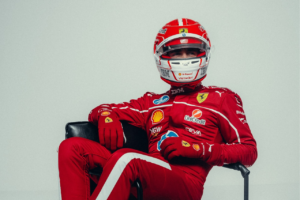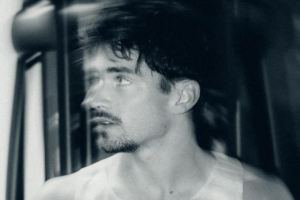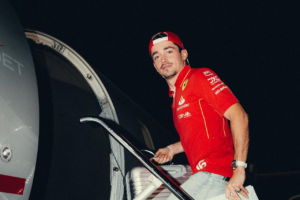The intersection of loss and legacy creates a uniquely poignant narrative in motorsport, where the pursuit of excellence often intertwines with profound personal sacrifice. For Charles Leclerc, this reality manifested in 2017 when he lost his father—his first mentor, biggest supporter, and the architect of his racing dreams—just one year before achieving their shared vision of reaching Formula 1.
The weight of this loss reveals itself most powerfully in a moment of both tenderness and guilt: during his father’s final days, Leclerc told a white lie. “I lied to him,” he recalls, voice tinged with emotion. “I told him I had signed my Formula 1 contract.” This confession, made with the knowledge that his father’s time was limited, initially haunted him. Yet fate would transform this moment of guilt into something approaching poetry when, just one month later, Leclerc did indeed secure his Formula 1 contract—a bittersweet validation that seemed to reach across the veil between life and death.

The crucible of grief has shaped Leclerc’s approach to racing in profound ways. When asked what drove him to race in Baku just days after his father’s passing, his response illuminates the depth of their connection: “As soon as he passed away, I asked myself what would he want me to do.” The answer was unequivocal—race, and race to win. This clarity of purpose, born from loss, has become a cornerstone of Leclerc’s resilience.
But the story of loss in Leclerc’s journey extends beyond family. The motorsport community, tight-knit despite its competitive nature, has experienced collective grief with the losses of Jules Bianchi in 2014 and Antoine Hubert in 2019. These tragedies present a unique psychological challenge: how does one continue to push the limits of speed and performance while processing the sport’s inherent dangers? For Leclerc, the answer lies in compartmentalization—a skill he’s developed with remarkable maturity. “You are racing on this exact same track, you are going through the exact same corner where a person that you were close with lost his life,” he reflects. “These are the two moments in my entire career where you have a bit of negative thoughts going into that corner and you need to battle a bit through them.”
This ability to acknowledge grief while maintaining focus speaks to a deeper truth about resilience—it’s not about the absence of fear or pain, but rather the capacity to carry these emotions while continuing to pursue excellence. Leclerc’s approach offers a master class in this delicate balance, demonstrating how personal loss can be transformed into fuel for achievement without diminishing its emotional significance.
The young Ferrari driver’s journey reminds us that resilience isn’t merely about bouncing back; it’s about moving forward while carrying the weight of what’s been lost. His story suggests that true strength lies not in suppressing grief but in allowing it to coexist with ambition, determination, and even joy—a lesson that resonates far beyond the confines of Formula 1.
In the rarefied world of Formula 1, where careers are often meticulously planned from childhood, Charles Leclerc’s origin story stands apart with its touch of serendipity. On a day that began with a child’s classic ruse—feigning illness to skip school—three-and-a-half-year-old Charles accompanied his father to visit a friend who owned a karting track. What followed would set in motion a journey that would transform both father and son, and ultimately, the landscape of Formula 1 itself.

That first encounter with karting captures the essence of pure, unbridled passion that would define Leclerc’s relationship with motorsport. Picture a tiny Charles, barely tall enough to see over the steering wheel, being towed around the track with a safety rope for his first lap. The rope came off, and the young driver refused to stop until the kart ran out of fuel—a metaphor, perhaps, for the relentless drive that would characterize his career.
The transition from this magical first encounter to serious competition happened with remarkable speed. By age five, Leclerc was already displaying the mindset of a professional, approaching each track session with a clear purpose: “Every time I was getting to the track, yes I love what I do, but I want to be the best.” This early manifestation of competitive spirit, tempered by his father’s constant emphasis on humility and gratitude, would create the foundation for Leclerc’s distinctive approach to racing.
The financial realities of nurturing a young racing talent created a complex backdrop to this fairy tale beginning. Motorsport, as Leclerc acknowledges, is “unfortunately a very expensive sport.” His father’s sacrifices—the careful saving, the long hours, the compromised time with family—were substantial. Yet Leclerc’s perspective on these sacrifices reveals much about his character: “I never like to say that I sacrificed anything in my life because I didn’t. I just did everything that I wanted to do, which was racing.”
This early period also saw the development of a goal-setting methodology that would serve Leclerc throughout his career. Rather than fixating on the distant dream of Formula 1, he focused on achievable targets two months ahead, creating a series of stepping stones that made the mountainous challenge of reaching F1 manageable. This approach, combining pragmatism with ambition, helped transform what might have remained a childhood fantasy into an achievable reality.
The story of these formative years is not just about learning to race; it’s about the cultivation of character. Through his father’s guidance, Leclerc learned that talent alone was insufficient—it needed to be paired with humility, hard work, and gratitude. These lessons, imparted on karting tracks and long drives to races, would prove as valuable as any technical skill in navigating the high-pressure world of Formula 1.
In many ways, these early years mirror the classic hero’s journey, complete with the fateful call to adventure, wise mentorship, and trials that would test both skill and character. But perhaps what makes Leclerc’s story particularly compelling is how the purity of that first love affair with karting remains evident in his approach to racing today—a reminder that at the heart of every professional achievement lies a child’s simple joy in doing what they love.
To the casual observer, Formula 1 might appear deceptively simple: sit in a car and drive very fast. Yet beneath this superficial assessment lies a world of physical and mental demands that would challenge even the most seasoned athletes. Through Charles Leclerc’s experiences, we glimpse the extraordinary preparation required to pilot these technological marvels at the absolute limit of human capability.
Consider the physical toll: during a single race, drivers can lose up to four kilograms of water weight, their bodies battling extreme temperatures within the cockpit while experiencing G-forces that would make a fighter pilot take notice. The neck muscles—a focus of particular attention in F1 training—must withstand forces that no ordinary gym routine could prepare them for. As Leclerc notes, “The neck is probably the hardest part to train properly because it’s full of little muscles that you don’t use and that is very difficult to reproduce in a gym.”

The evolution of Leclerc’s approach to race preparation tells a story of hard-won wisdom. His rookie season, by his own admission, was “a mess”—characterized by last-minute flights and inadequate recovery time. The transformation from this haphazard approach to his current meticulously planned routine reveals the learning curve all elite athletes must navigate. Today, his preparation includes a precise sleep schedule (10-11 hours per night), carefully timed cold therapy sessions, and a scientifically calibrated diet managed by a specialist in Milan.
The dietary requirements of an F1 driver represent another layer of complexity. Weight fluctuations throughout a race weekend must be carefully managed, with carbohydrate loading before practice sessions balanced against the extreme fluid loss during races. This delicate dance of nutrition and hydration requires constant attention and adjustment, particularly given the global nature of the F1 calendar and its varying climates and time zones.
Perhaps most striking is the limited opportunity for actual practice in the car—just three days per year in the new machine before the season begins. This constraint elevates the importance of simulator training, though as Leclerc explains, no simulation can fully replicate the visceral experience of actual G-forces or the adrenaline of real racing. It’s a reminder that while technology has revolutionized training methods, the fundamental challenges of the sport remain deeply physical and intensely human.
Recovery becomes as crucial as preparation, with Leclerc embracing both traditional and cutting-edge techniques. Cold baths bookend his race days, serving both to prepare his body for the extreme temperatures ahead and to aid in recovery afterward. This attention to recovery reflects a broader understanding in modern motorsport: that performance isn’t just about peak output, but about sustainable excellence over a grueling 24-race season.

The mental demands prove equally challenging. Drivers must maintain razor-sharp focus while processing countless inputs at speeds exceeding 200 mph, making split-second decisions where the margin for error is measured in millimeters. Racing involves a unique form of mindfulness—a complete presence in the moment where past mistakes must be instantly forgotten, and future consequences cannot be dwelt upon.
This comprehensive approach to physical and mental preparation illustrates a fundamental truth about modern Formula 1: it demands not just exceptional driving talent, but a holistic commitment to excellence in every aspect of life. From sleep patterns to nutrition, from physical conditioning to mental resilience, success in F1 requires an almost monastic dedication to self-optimization. In Leclerc’s journey from rookie to championship contender, we see the evolution not just of a driver, but of an athlete who has learned to harmonize the multiple demands of one of sport’s most challenging disciplines.
In the high-stakes world of Formula 1, where speed and precision reign supreme, Charles Leclerc’s journey is marked by a profound understanding of life’s most delicate moments. His story of loss and resilience offers a masterclass in how grief can coexist with greatness, and how personal tragedy can shape—but not define—a champion’s path.
The pivotal moment came in 2017, when Leclerc, then on the cusp of his Formula 1 dreams, faced the imminent loss of his father. In what would become their final conversation, the young driver made a decision that would haunt him for months: he told his father he had secured a Formula 1 contract—a white lie meant to bring peace to a dying man’s last moments. “My mom was pretty angry with me,” Leclerc recalls, “telling me you shouldn’t lie to your father.” Yet fate would write a poetic epilogue to this moment when, just one month later, Leclerc did indeed sign his Formula 1 contract, transforming what began as a comforting fiction into fulfilled prophecy.
The weight of this period crystallized in a singular question Leclerc asked himself immediately after his father’s passing: “What would he want me to do?” The answer led him to Baku for a Formula 2 race mere days after his loss, driven by the certainty that his father, who lived for racing and found his greatest joy in his son’s victories, would want him to compete. This clarity of purpose, born from grief, became a cornerstone of his resilience.
But the story of loss in Formula 1 extends beyond personal tragedy. The sport’s inherent dangers manifested in the deaths of Jules Bianchi in 2014 and Antoine Hubert in 2019, both dear friends to Leclerc. These losses brought a different dimension to his relationship with racing, particularly when competing on the very tracks where these tragedies occurred. “You are racing on this exact same track,” he reflects, “going through the exact same corner where a person that you were close with lost his life.”
What emerges from these experiences is not just a story of survival, but of transformation. At seventeen, Leclerc suddenly found himself stepping into adult responsibilities—caring for his younger brother, supporting his mother, all while pursuing the most demanding career in motorsport. This accelerated maturity, though forced by circumstance, has imbued him with a rare combination of competitive fire and emotional intelligence.
Today, Leclerc’s approach to racing reflects this duality. His pursuit of excellence remains undiminished, yet it’s tempered by a profound appreciation for life’s fragility and the importance of making each moment count. During difficult race weekends, he draws strength from remembering his earliest days in karting, reconnecting with the pure joy that first drew him to the sport.
The lesson in Leclerc’s story isn’t just about overcoming loss—it’s about integrating it into one’s journey. His experience demonstrates that resilience isn’t about moving past grief, but about learning to carry it while continuing to pursue excellence. In this way, his losses haven’t diminished his competitive spirit; they’ve added layers of meaning to every victory, every podium, every lap.
In Formula 1, where the difference between success and failure is often measured in milliseconds, Leclerc has found that his greatest strength comes not from shutting out emotion, but from channeling it into purpose. His story reminds us that true resilience isn’t about being unbreakable—it’s about finding strength in our vulnerabilities and purpose in our pain.

The evolution of Formula 1 from its raw, mechanical origins to today’s digital era presents a fascinating study in how technology has both simplified and complexified the art of racing. Through Charles Leclerc’s unique perspective—spanning both modern machinery and classic cars like Niki Lauda’s legendary Ferrari—we gain insight into this remarkable transformation of motorsport’s pinnacle discipline.
Consider the fundamental act of changing gears. In Lauda’s era, this demanded a complex dance of clutch, shifter, and precise timing—a symphony of mechanical interaction that required absolute concentration. Today’s F1 cars, by contrast, have transformed this process into a simple press of a paddle, freeing the driver’s cognitive bandwidth for the countless other decisions required at 200+ mph. As Leclerc notes, “Now in a Formula 1 car everything is electronic… your brain can focus on many many other things.”
Yet this technical evolution has introduced its own unique challenges. Modern F1 drivers face an almost paradoxical constraint: they have just three days to master their new machines before the season begins. This limited testing window would have been unthinkable in previous eras, forcing today’s drivers to rely heavily on simulator training—a technology that, while sophisticated, cannot fully replicate the visceral experience of actual racing.
The simulator itself represents a fascinating intersection of virtual and physical reality. Housed in a room “five or six times bigger than this one” at Maranello, Ferrari’s advanced simulator attempts to reproduce G-forces and car behavior with remarkable precision. However, as Leclerc explains, it can never fully capture the sustained G-forces or the high-stakes environment of actual racing: “You crash, you press the restart button and you go again, which in reality is a bit more difficult.”
The contemporary F1 car has evolved into something akin to a data center on wheels, with drivers managing hundreds of controls on their steering wheels while racing at the limit. This technological sophistication has transformed the relationship between driver and engineer, requiring a level of technical understanding and communication that would have been unnecessary in previous eras. The modern F1 driver must be part athlete, part technician, and part data analyst.
Perhaps the most striking contrast lies in the safety advancements. When Leclerc drove Lauda’s historic Ferrari, he encountered a stark reminder of the sport’s evolution: “Where they had the legs is just something like this of metal.” This observation underscores how far F1 has progressed in protecting its drivers, allowing them to push the limits with greater confidence while maintaining respect for the sport’s inherent risks.
Yet for all its technical sophistication, modern F1 remains fundamentally human. The challenge of extracting maximum performance from these complex machines still requires exceptional skill, judgment, and courage. The technical evolution hasn’t made the sport easier—it has simply shifted the boundaries of what’s possible, creating new challenges while solving others.
This balance between human and machine, between traditional skill and modern technology, continues to define Formula 1’s evolution. As Leclerc’s experience demonstrates, success in modern F1 requires not just raw talent but an ability to adapt to and embrace technological change while maintaining the fundamental skills that have always defined great racing drivers. It’s a reminder that in F1, as in many fields, progress doesn’t necessarily simplify—it often adds layers of complexity that require new forms of mastery.
In the pressure cooker of Formula 1, where every move is scrutinized and every decision can impact a career, Charles Leclerc has crafted a personal sanctuary that extends beyond the confines of the paddock. His approach to maintaining equilibrium in a world of extremes offers insights into how one might preserve authenticity while navigating the spotlight of modern fame.
The discovery of piano during the Covid lockdown period reveals much about Leclerc’s character. What began as a simple diversion from simulator racing has evolved into a profound source of solace. “Sometimes I thought I would be on the piano for an hour,” he reflects, “and I will look at the time and it will be four or five hours past.” This immersion in music provides more than mere entertainment—it offers a rare space where the precise calculations and split-second decisions of racing can give way to pure creative expression.
The complexities of friendship in Formula 1 present another fascinating dimension of Leclerc’s personal life. His relationship with Pierre Gasly, dating back to their karting days in 2005, demonstrates how childhood bonds can survive and even thrive within the sport’s intensely competitive environment. Yet there’s a striking duality to this friendship: “As soon as I close the visor and I’m with a helmet, he’s nobody anymore,” Leclerc admits, before adding, “and that’s the same for him.” This ability to compartmentalize competition and companionship speaks to an emotional intelligence that extends beyond the racetrack.
Managing public perception in the age of social media presents its own unique challenges. Leclerc’s experience with online criticism, particularly regarding his character, touches on a universal modern struggle. “Someone was saying ‘Oh look how arrogant he is,'” he recalls, “and these are critics that really hurt me because I know I’m not like this.” His response to such challenges—focusing on maintaining authenticity while acknowledging that universal popularity is impossible—offers a masterclass in navigating public life with grace.
The maintenance of humility, a value instilled by his father, remains central to Leclerc’s character despite his meteoric rise. This quality was particularly evident during a recent visit to a karting race, where he experienced the surreal transition from being the wide-eyed child meeting Michael Schumacher to becoming the Formula 1 star inspiring the next generation. His recognition that “the smallest gesture… will change my life for months” demonstrates a profound understanding of his position’s influence and responsibility.
Perhaps most revealing is Leclerc’s approach to competition itself. While his drive to win remains fierce, it’s tempered by an awareness that extends beyond the podium. His ability to maintain perspective—to remember the child who dreamed of Ferrari while handling the pressures of actually driving for them—speaks to a maturity that transcends his years.

In these various aspects of his personal life, we see the framework of a character built to withstand the particular pressures of modern sporting stardom. Leclerc’s story reminds us that even in the most competitive environments, there’s room for friendship, creativity, and personal growth. His journey suggests that true character development isn’t about eliminating pressure or avoiding challenges, but about finding authentic ways to channel them into positive growth.
Through music, friendship, and a commitment to remaining true to his values, Leclerc has crafted a life that extends beyond the confines of his profession while enhancing his ability to perform within it. It’s a delicate balance, but one that offers valuable lessons for anyone navigating the intersection of personal authenticity and professional excellence.
In the rarefied air of Formula 1, where success is measured in milliseconds and championships, Charles Leclerc’s vision of his future and legacy transcends the mere accumulation of trophies. His aspirations are woven from threads of personal history, family values, and a deep-seated desire to honor both his sport’s traditions and his father’s teachings.
The pursuit of a World Championship sits at the heart of Leclerc’s professional ambitions, yet his approach to this goal reveals a maturity beyond his years. “Victory, the taste of victory is what motivates me every morning,” he explains. But it’s not just personal glory that drives him—it’s the knowledge that each triumph represents the collective achievement of over 1,500 people working tirelessly at Maranello. This understanding transforms his individual pursuit into a shared journey, adding layers of meaning to each step toward the championship.
Perhaps most touching is how Leclerc’s interaction with young drivers has come full circle. Recently, visiting a karting race to watch his younger cousin compete, he experienced a profound moment of perspective. Standing there as a Ferrari Formula 1 driver, surrounded by wide-eyed children who viewed him as he once viewed his heroes, Leclerc recognized the weight of his influence. “I remember that day still as if it was yesterday,” he recalls of his own childhood encounter with Michael Schumacher, understanding now how such brief moments can inspire lifelong dreams.
His vision for post-racing life reveals an interesting duality—while architecture interests him as a potential future pursuit, his present focus remains firmly on maximizing his racing career. This balance between acknowledging future possibilities while maintaining present focus exemplifies the mindset that has brought him success thus far.
The legacy Leclerc seeks to build extends beyond racing achievements. His father’s twin mantras of humility and gratitude continue to guide his path, even as he reaches heights his younger self could only dream of. In every interaction with fans, every moment spent with young drivers, and every race weekend, these values manifest in ways both small and significant. “I think I will have lived so badly with a lie like this for the rest of my life,” he reflects on telling his father about the F1 contract, demonstrating how these core values influence even his most personal decisions.
Looking ahead, Leclerc’s approach to legacy-building seems to mirror his racing strategy—focused yet flexible, ambitious yet grounded. His commitment to authenticity in an era of carefully curated public personas stands out particularly. Whether addressing social media criticism or discussing his vulnerabilities, his transparency adds a human dimension to the often-mythologized world of Formula 1 drivers.
The future Leclerc envisions is one where success and humility coexist, where achieving excellence doesn’t require compromising values, and where inspiring the next generation becomes as important as personal achievement. It’s a vision that honors his father’s memory while charting new territory, maintaining the delicate balance between respecting tradition and embracing progress.
In many ways, Leclerc’s aspirations represent a modern interpretation of timeless values—excellence tempered by humility, ambition guided by gratitude, and success measured not just in championships, but in the lives touched and dreams inspired along the way. As he continues his quest for World Championship glory, his journey suggests that the most meaningful legacies are built not just on what we achieve, but on how we achieve it.
In the high-stakes world of Formula 1, where technology and talent converge at breakneck speeds, Charles Leclerc’s story stands as a testament to something more profound than mere athletic achievement. It’s a narrative that speaks to the fundamental elements of excellence—not just in motorsport, but in any pursuit where passion meets purpose.
At its core, Leclerc’s journey illuminates the delicate balance between technical mastery and human emotion. From that first serendipitous encounter with karting at age three and a half to his position as Ferrari’s youngest driver, his path has been marked by an unusual combination of precision and poetry. The technical demands of modern F1—managing hundreds of controls while experiencing extreme G-forces, adapting to ever-evolving technology, maintaining peak physical condition—are matched only by the emotional intelligence required to process personal loss, public pressure, and the weight of representing one of motorsport’s most storied teams.
Perhaps most striking is how Leclerc has transformed potential barriers into bridges. The loss of his father, rather than derailing his ambitions, deepened his connection to the sport. The pressure of social media scrutiny has led not to a carefully curated public persona, but to a commitment to authentic self-expression. Even the intense rivalry of F1 hasn’t prevented him from maintaining genuine friendships within the paddock, most notably with Pierre Gasly.
His approach to excellence is both systematic and soulful. The rigorous physical preparation—from precisely timed cold baths to carefully monitored sleep patterns—exists alongside moments of pure joy, like losing track of time while playing piano. This duality suggests that true excellence isn’t about sacrificing one aspect of life for another, but about finding harmony between technical precision and human expression.
Leclerc’s story reminds us that the path to excellence is rarely linear. It’s shaped by serendipitous moments (like that first day at the karting track), defined by how we handle loss and setback, and sustained by an ability to maintain perspective even as success grows. His father’s emphasis on humility and gratitude hasn’t just survived success—it’s become instrumental to achieving it.

As Leclerc continues his pursuit of a World Championship, his journey offers a blueprint for excellence that transcends motorsport. It suggests that greatness isn’t just about reaching the pinnacle of one’s field, but about how we conduct ourselves on the climb. In an era often characterized by carefully constructed public images, his authentic approach to both triumph and challenge reminds us that true excellence isn’t just about what we achieve—it’s about who we become in the process.
In the end, Charles Leclerc’s story isn’t just about a driver’s quest for Formula 1 glory. It’s about the eternal dance between technical mastery and human emotion, between individual achievement and collective purpose, between honoring tradition and embracing progress. It’s a reminder that in any field, the pursuit of excellence is as much about the journey as the destination, and that our greatest achievements often come not when we focus solely on the goal, but when we remain true to the values that guide us toward it.


